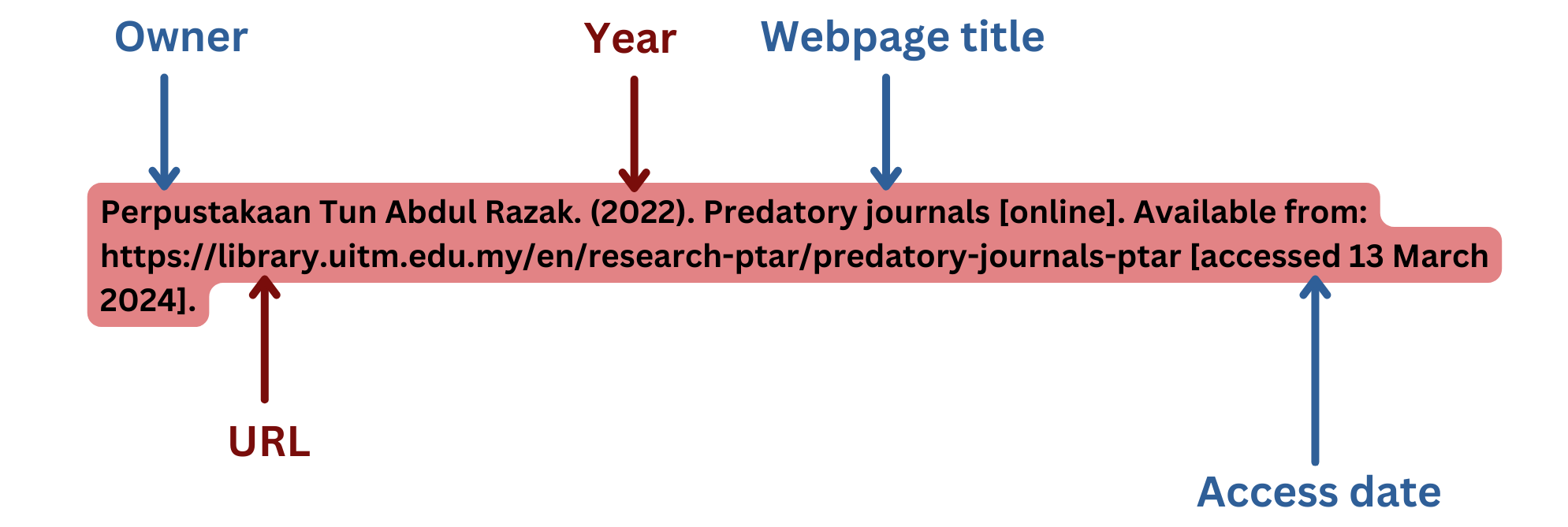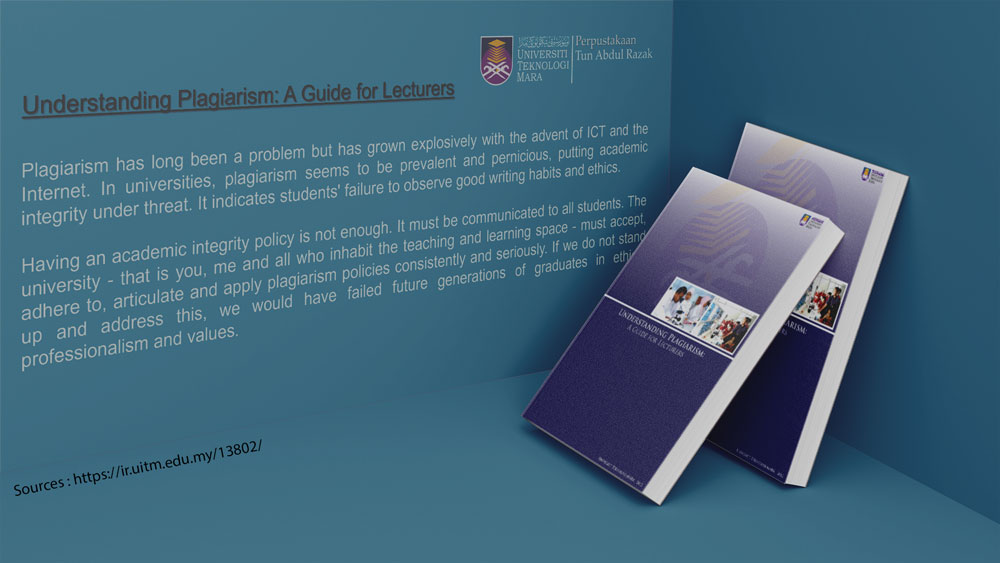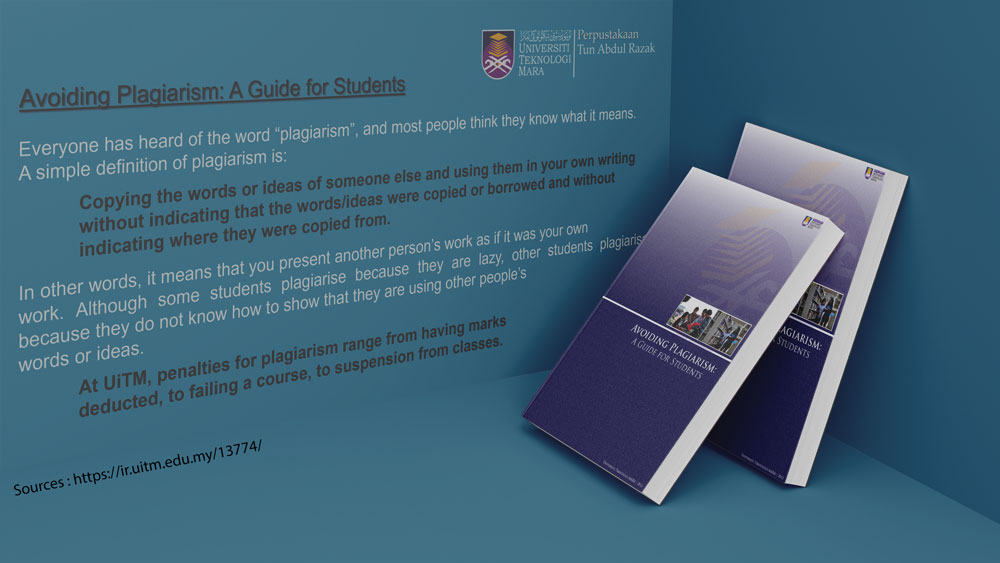- Copying and submitting the work of others (including books, articles, theses, unpublished works, working papers, seminars, conference papers, research data, internal reports, lecture notes or tapes, music, computer source code, website content, creative or visual artifacts, designs or ideas) without due acknowledgment.
- Too closely paraphrasing sentences, paragraphs, or themes without due acknowledgment.
- Translating the work of others without due acknowledgment.
- Presenting work produced by someone else as one’s own (e.g. allowing or hiring another person to do the work for which the student claims authorship)[Includes outsourcing of whole or part of the assessment to others (knowledgeprenuers). For example, students get others to analyze data and write the analysis or do their project].
- Submitting one's own previously assessed or published work without appropriate acknowledgment (self-plagiarism). Includes assignments submitted for other courses and theses developed and/ or submitted to another university.
- In the case of group projects, falsely represent the individual contribution of the collaborating partners.
- Fabricating (creating data) or doctoring data (changing data) as part of the submission.
The most usual format for in-text citations is a brief parenthetical remark that includes the source's author, publication year, and, if applicable, the source's page number. e.g.:-
| APA Style | …the elements you want from the different galleries (Smith, 2015). |
| MLA Style | …the elements you want from the different galleries (Smith). |
| IEEE Style | …the elements you want from the different galleries [1]. |
- Avoid plagiarism by acknowledging the original author’s contribution
- Allow readers to verify your claims and do follow-up research
- Show you are engaging with the literature of your field
- Parenthetical Citations or Author-date citations (used in APA, Harvard, and Chicago author-date) include the author’s last name, the year of publication, and a page number when available. Author-page citations (used in MLA) are the same except that the year is not included.
- Numerical citations include a number in brackets or in superscript, which corresponds to an entry in your numbered reference list (ACS, AMA, CSE, IEEE, NLM, Vancouver).
- Note citations include a full citation in a footnote or endnote, which is indicated in the text with a superscript number or symbol (Bluebook, Chicago, OSCOLA, UiTM Law In-House Style).
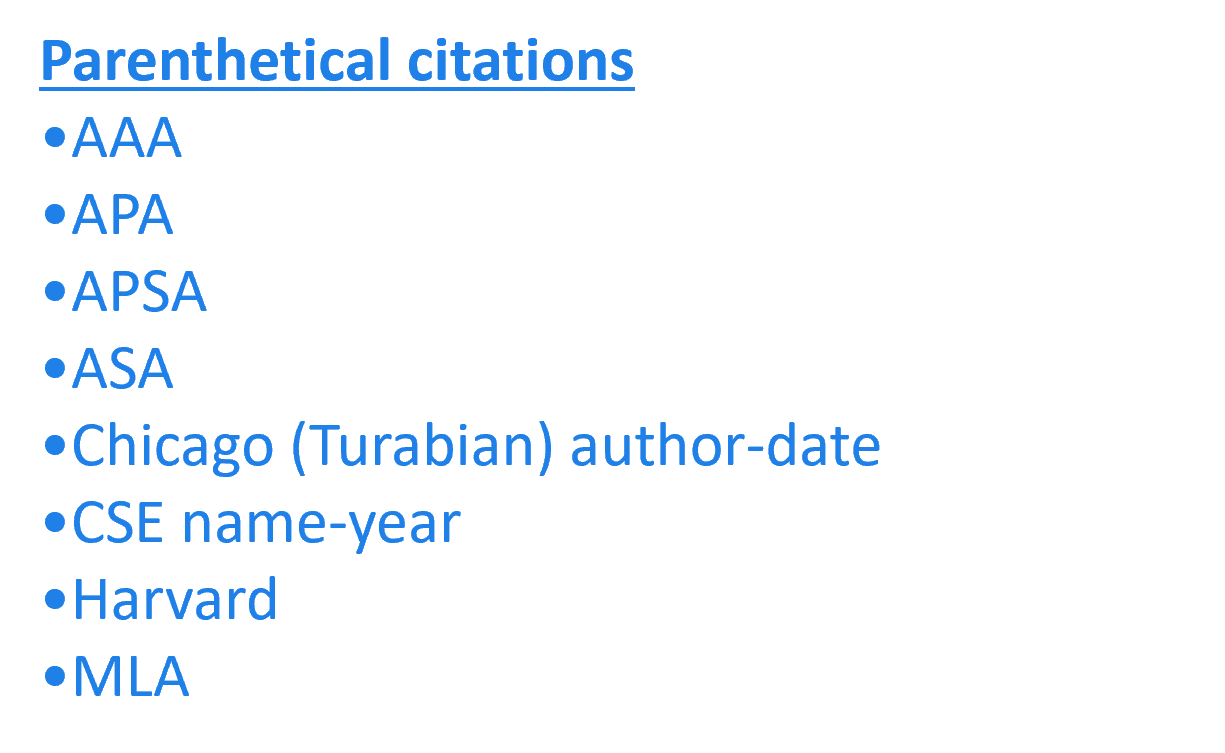
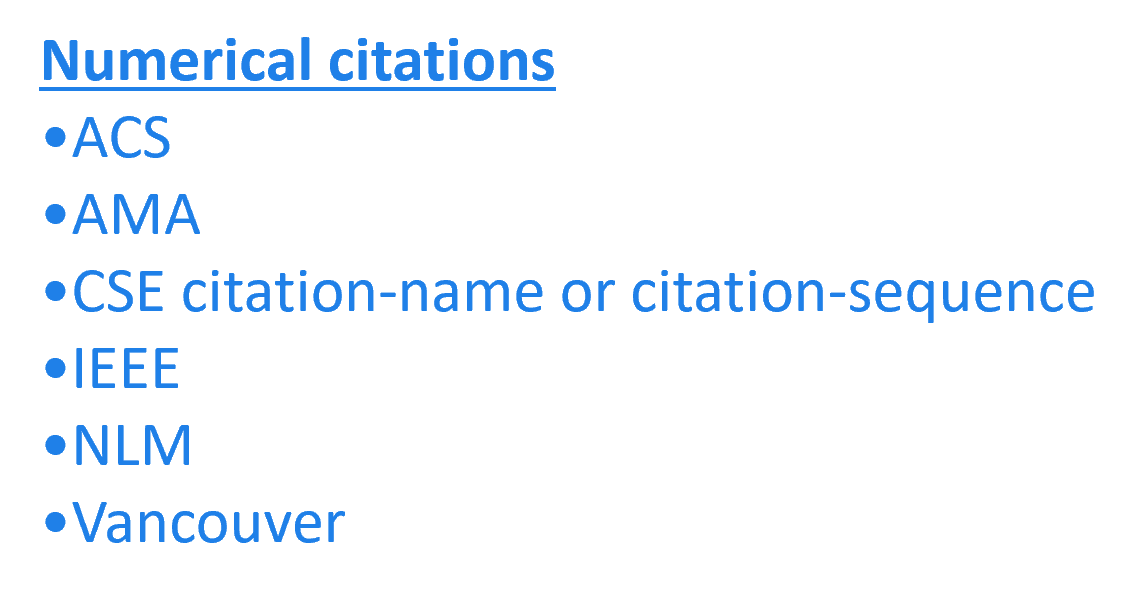

Each in-text citation gives just enough information on a particular source to “point” the reader to the corresponding, more detailed entry on the reference list.
e.g.: Numerous studies in the field of total quality management (TQM) practices have indicated a positive effect of these practices on the performance of companies (Adebanjo and Kehoe, 1999; Al-Dujaili, 2013; Kaynak, 2003; Hanson and Eriksson, 2002; Lepist et al., 1996; Sadikoglu and Zehir, 2010).
For narrative statement (direct quoting) means including the original author’s words directly in your text, usually introduced by a signal phrase. Quotes should always be cited (and indicated with quotation marks), and you should include a page number indicating where in the source the quote can be found.
e.g.: “The systematic development of literacy and schooling meant a new division in society, between the educated and the uneducated” (Cook-Gumpers, 1986, p. 27).
It also means 'to state something written or spoken in different words, especially in a shorter and simpler form to make the meaning clearer' (Cambridge Online Dictionary, 2022).
- Using quote marks around someone else's exact words is known as quoting.
- When you paraphrase, you give some else's thoughts your own style while maintaining the original meaning.
- Summarizing is the process of distilling the major points from a lenghty portion of someone else's writing into your own words.
- To further clarify or make a challenging paragraph easier to understand.
- Paraphrasing clarifies the passage's point by demonstrating to the reader that you comprehend it. It also shows that you are informed about the subject and deserving of their trust because you are able to communicate this challenging message.
- To keep the writing's flow intact.
- Utilizing straight quotations can stifle an author's individual voice. An essay may sound choppy and confusing if it contains too many quotes. Without disrupting the essay's flow, paraphrasing can help explain a significant notion in a text or source.
- To omit information that isn't important.
- Since the author's words are used while paraphrasing, the writer has more discretion over what details from a chapter to include or leave out.
- So as not to plagiarize.
- Always remember to cite the paraphrased content using an in-text citation and a complete reference list at the end of the paper.

The word 'may' can be replaced with 'it is likely to' and 'put upward pressure on' is replaced with 'push up'.
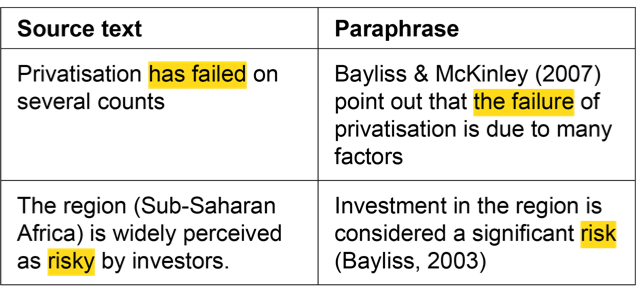
In the first paraphrase, a verb has been replaced with a noun from the same word family. In the second, an adjective has been replace by a noun.
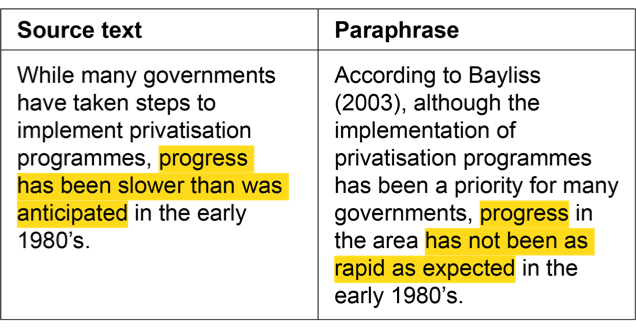
Here, one grammatical structure for making a comparison 'slower than' has been replaced with another 'not as rapid as'.
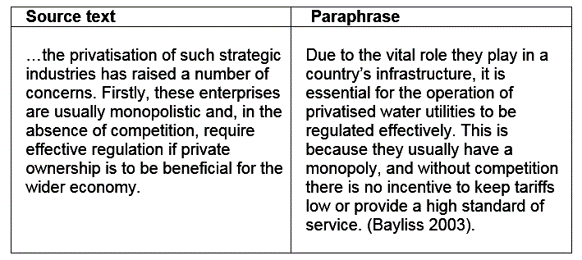
In this final example, you will notice that:
- the order in which information is presented is different in the paraphrase
- different word forms in the same word family have been used (effective regulation > regulated effectively)
- the phrases 'in the absence of competition' and 'without competition' have been used as synonyms.
How you present these citations depends on the style you follow or use.
Different styles are set by different universities, academic associations, and publishers, often published in an official handbook with in-depth instructions and examples.
There are many different citation styles, but they typically use one of three basic approaches: parenthetical citations, numerical citations, or note citations.
E.g. : APA, MLA, IEEE, Chicago, Turabian, Harvard, etc…
If you’re submitting to a journal, they will usually require a specific style which normally you will be informed by the publisher itself.
| In-text citation | Reference list |
| (Author(s), Year) | Author, A. A. (Year of publication). Title of work: Capital letter also for subtitle (# edition). Publisher. |
| Examples | |
| (Bernstein, 2021) | Bernstein, J. (2021). Google apps made easy: Learn to work in the cloud (7th ed.). CreateSpace. |
| (Giddens & Sutton, 2021) |
Giddens, A. & Sutton, P.W. (2021). Sociology (9th ed.). Polity Press. |
| (Shortle et al., 2020) |
Shortle, J.F., Thompson, J.M., Gross D. & Harris, C.M. (2018). Fundamentals of queueing theory (5th ed.). Wiley. |
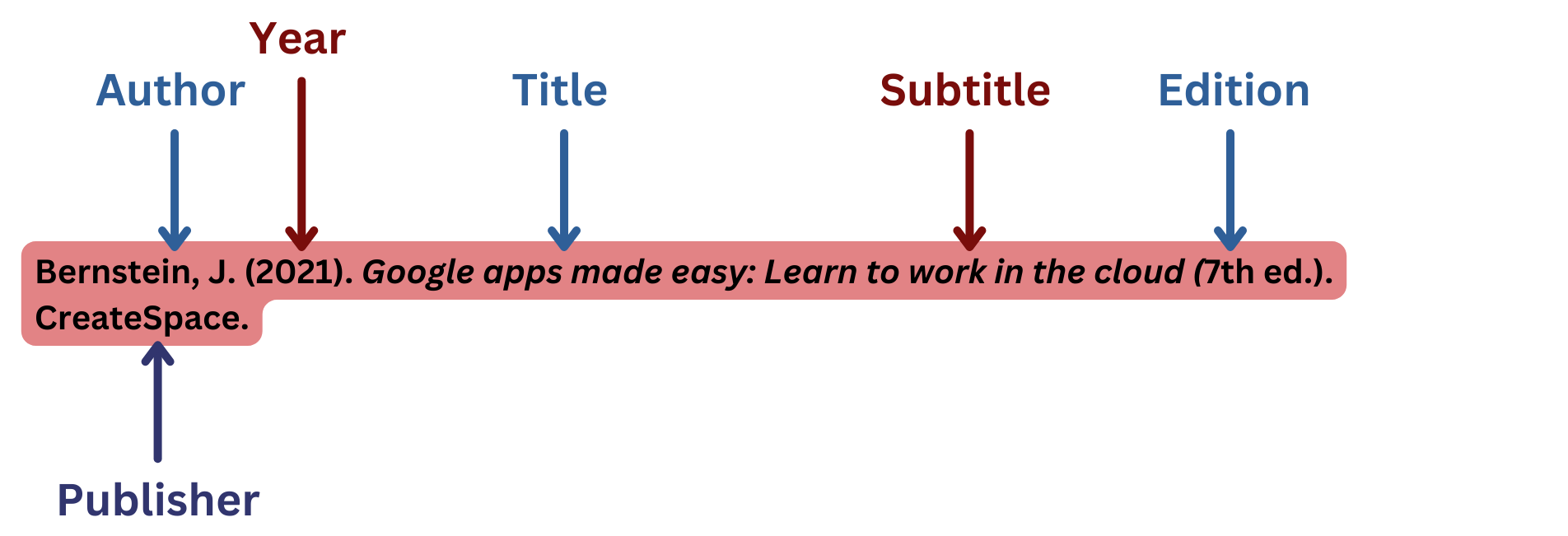
Use when referring to a single chapter in an edited book.
| In-text citation | Reference list |
| (Chapter author’s, Year) | Author, A. A., & Author, B. B. (Year of publication). Title of chapter. In E. E. Editor & F. F. Editor (Eds.), Title of work: Capital letter also for subtitle (pp. pages of chapter). Publisher. |
| Example | |
| (Rodgers et al., 2023) |
Rodgers, A.S., Agg, C., Gironacci E., Collingwood J.F. & Popham T.J. (2023). An innovative framework for the design of higher education STEM induction programmes. In: Willison, D. & Henderson, E., (Eds.). Perspectives on enhancing student transition into higher education and beyond. (pp. 69-94). IGI Global. |
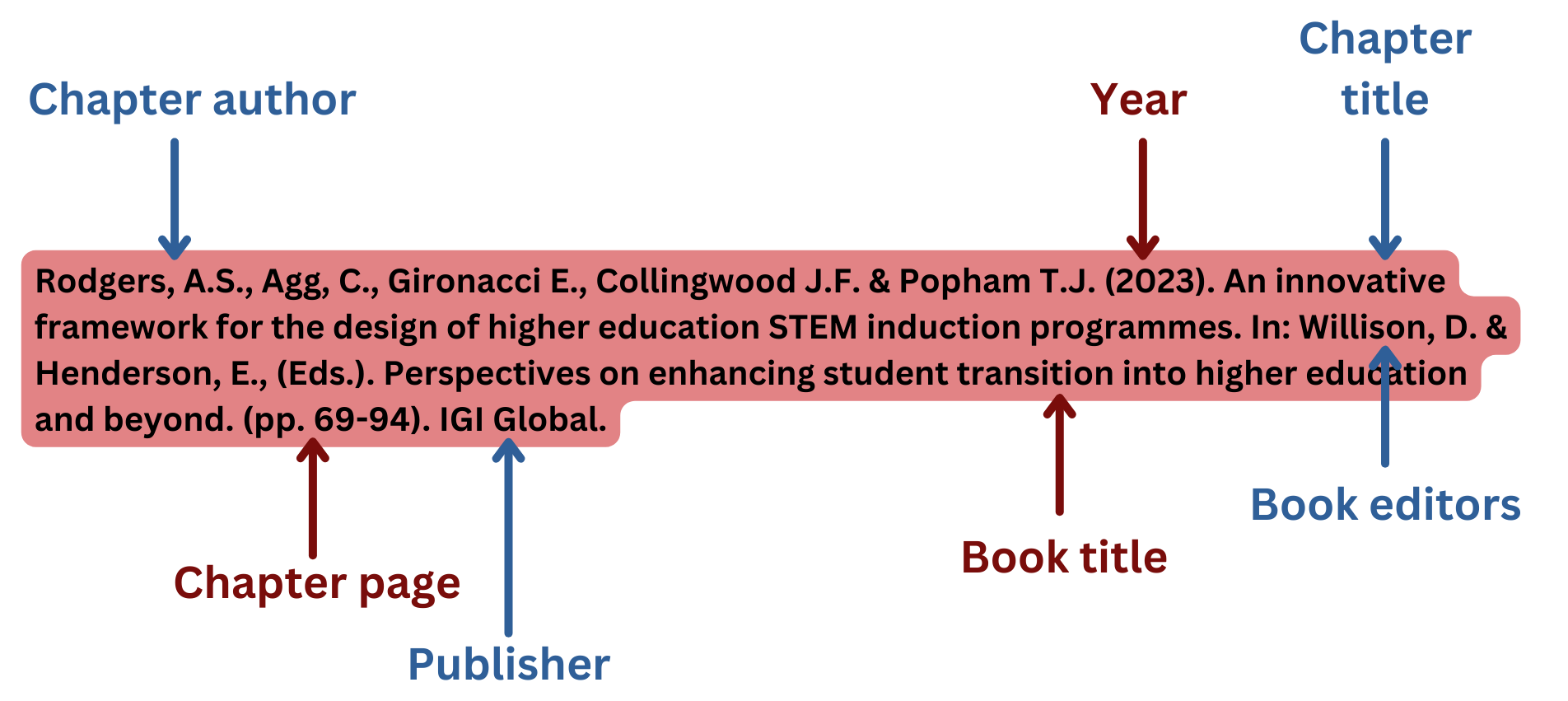
Use when referring to the entire book
| In-text citation | Reference list |
| (Editor, Year) | Editor, E. E. (Ed.). (Year of publication). Title of work: Capital letter also for subtitle. Publisher. |
| Example | |
| (Willison & Henderson, 2023) |
Willison, D. & Henderson, E. (Eds.). (2023). Perspectives on enhancing student transition into higher education and beyond. IGI Global. |

| In-text citation | Reference list |
| (Author Year) | [With DOI] Lastname, F. M., & Lastname, F. M. (Year). Title of article. Title of Periodical, Vol.(Issue), page numbers. DOI [Without DOI] Lastname, F. M., & Lastname, F. M. (Year). Title of article. Database name. Retrieved Month Day, Year, from URL |
| Examples | |
|
(Ekström, 2022) |
Ekström, B. (2022). A niche of their own: variations of information practices in biodiversity citizen science. Journal of Documentation, 78(7), 90-98. https://doi-org.ezaccess.library.uitm.edu.my/10.1108/JD-07-2021-0146 |
| (Ekström, 2022) | Ekström, B. (2022). A niche of their own: variations of information practices in biodiversity citizen science. Emerlad Insight. Retrieved August 30, 2023, from https://www.emerald.com/insight/content/doi/10.1108/JD-07-2021-0146/full/html |
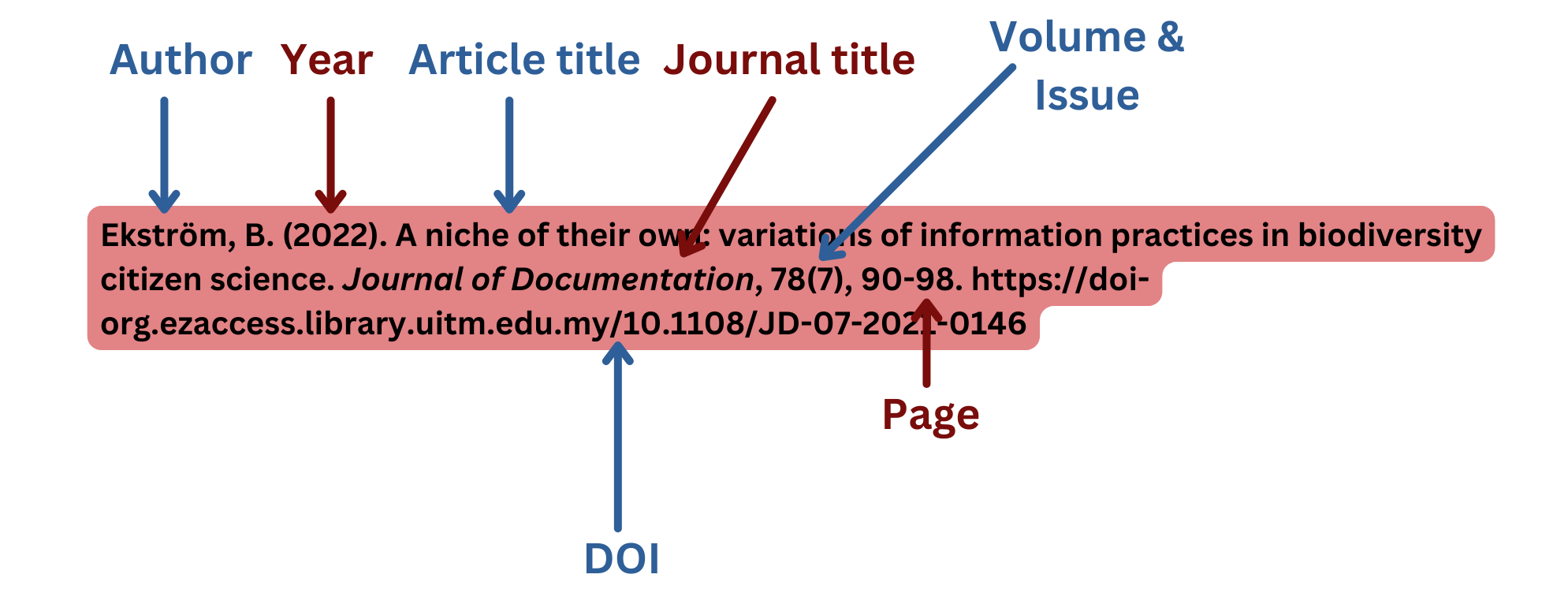
| In-text citation | Reference list |
| (Author, Year) | Lastname, F. M. (Year). Title of book. Publisher. URL Lastname, F. M. (Year). Title of book [eBook edition]. Publisher. URL Lastname, F. M. (Year). Title of book (N. Narrator, Narr.) [Audiobook]. Publisher. URL (if applicable) |
| Examples | |
| (Harries, 2009) | Harries, K. (2009). Art matters: a critical commentary on Heidegger’s “The Origin of the Work of Art”. Springer Dordrecht. https://link-springer-com.uitm.idm.oclc.org/book/10.1007/978-1-4020-9989-2. |
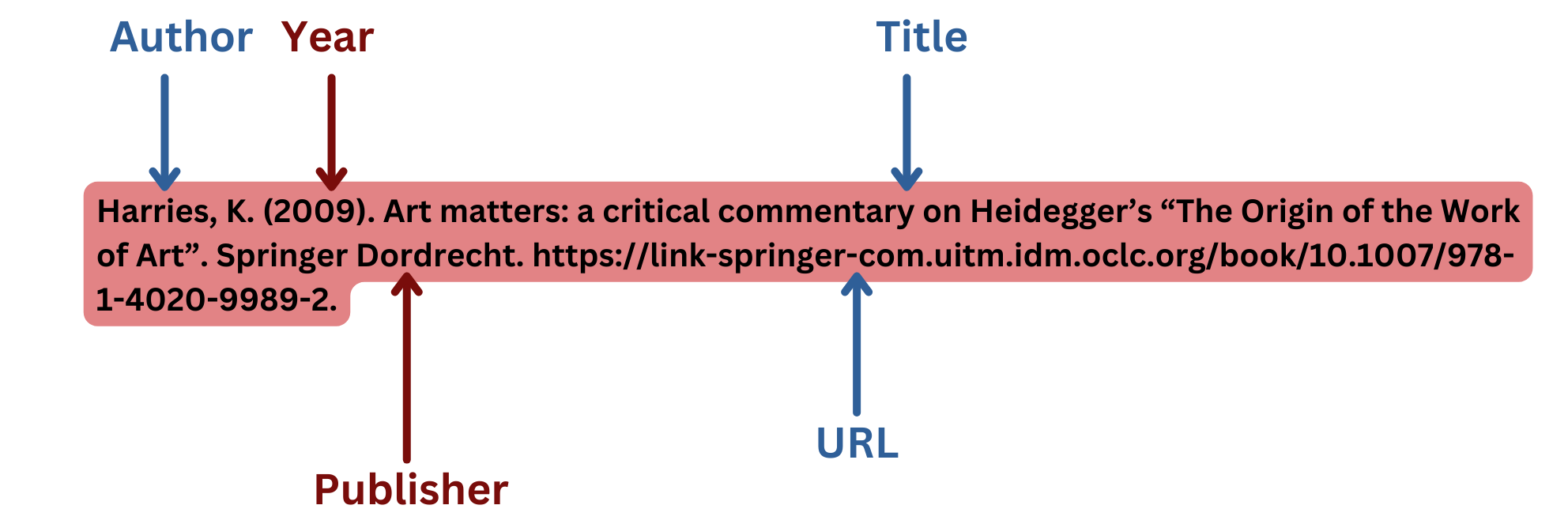
Material on the Web often falls into one of the material types already covered in this guide. Information published on the Web is not necessarily a webpage. In such cases, follow the instructions for the material type in question (e.g. research report, e-book).
| In-text citation | Reference list |
| (Author/Owner, Year) | Author/Owner of webpage. (Year, Month Date). Title of webpage. Site name. URL |
| Example | |
| (Perpustakaan Tun Abdul Razak, 2022) | Perpustakaan Tun Abdul Razak. (2023, September 5). Predatory journals. Perpustakaan Tun Abdul Razak. https://library.uitm.edu.my/en/research-ptar/predatory-journals-ptar |

| In-text citation | Reference list |
| (Author(s) page) | Last Name, First Name. Title of Book. Edition followed by ed. City of Publication, Publisher, Publication Date. |
| Examples | |
| (Bernstein 98) | Bernstein, James. Google apps made easy: Learn to work in the cloud. 7th ed. United States, CreateSpace, 2021. |
| (Giddens and Sutton 98) |
Giddens, Anthony and Philip W. Sutton. Sociology. 9th ed. Cambridge, Polity Press, 2021. |
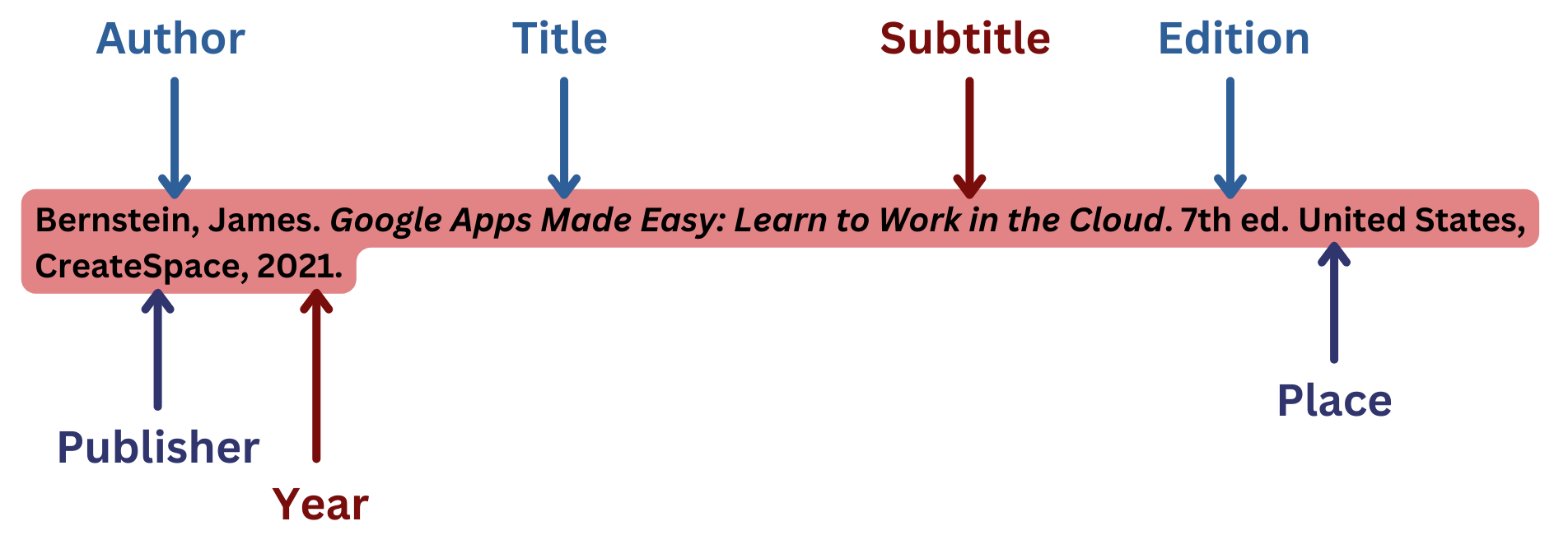
Use when referring to a single chapter in an edited book.
| In-text citation | Reference list |
| (Author(s) page) | Last name, First name. "Title of Chapter." Title of Collection, edited by Editor's Name(s), Publisher, Year, Page range of entry. |
| Example | |
| (Rodgers et al. 69-94) |
Rodgers, Alicia S., Chloe Agg, Elia Gironacci, Joanna F. Collingwood, and Thomas J. Popham. "An Innovative Framework for the Design of Higher Education STEM Induction Programmes". Perspectives on Enhancing Student Transition Into Higher Education and Beyond edited by Willson, Debra and Emma Henderson. IGI Global, 2023, pp.69-94. |
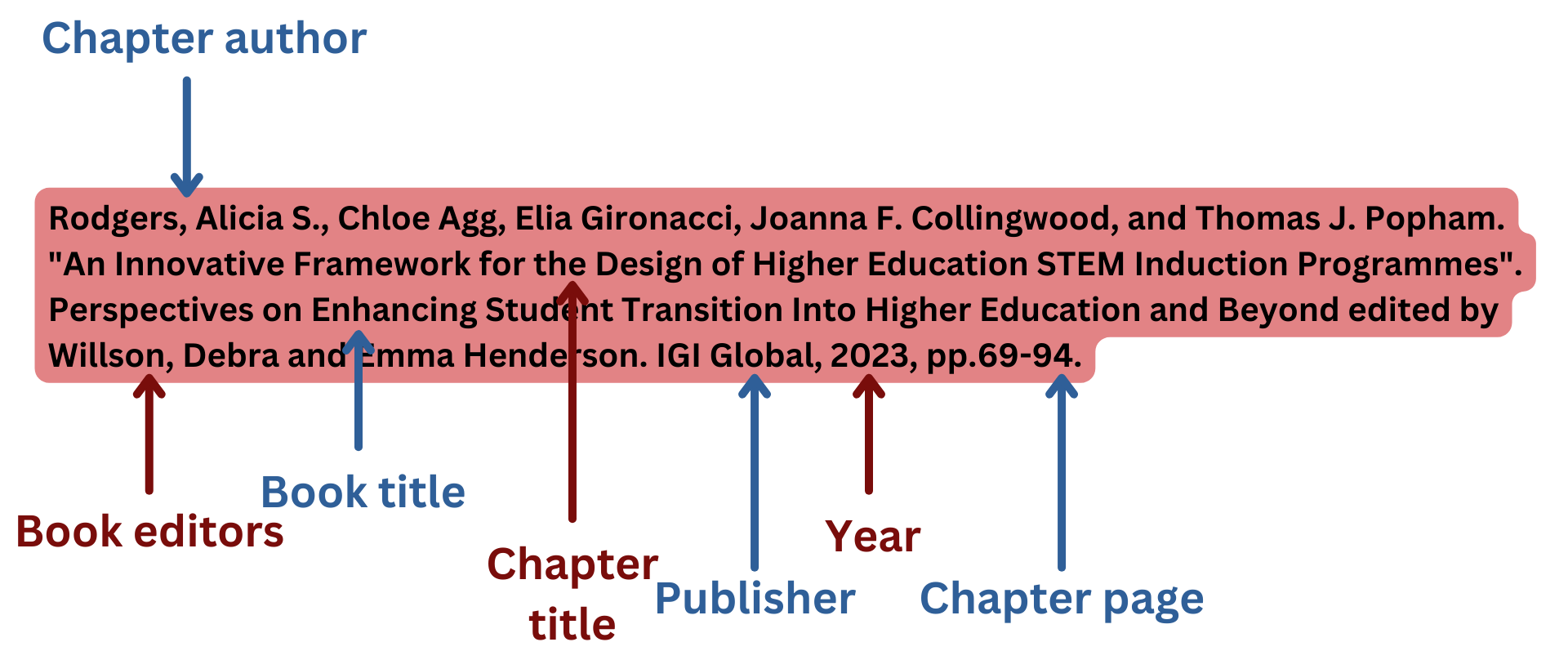
Use when referring to the entire book
| In-text citation | Reference list |
| (Editor Page) | Title of Book, edited by Editor First Name Last Name, City of Publication, Publisher, Publication Date. |
| Example | |
| (Willison and Henderson 100) |
Perspectives on enhancing student transition into higher education and beyond, edited by Debra Willison and Emma Henderson, United States, IGI Global, 2023. |

| In-text citation | Reference list |
| (Author page) | Author(s). "Title of Article." Title of Journal, Volume, Issue, Year, pages. DOI/URL. |
| Examples | |
|
(Ekström 2022) |
Ekström, Björn. "A Niche of Their Own: Variations of Information Practices in Biodiversity Citizen Science", Journal of Documentation, vol.78, no. 7, 2022, pp.248-265. https://www-emerald-com.ezaccess.library.uitm.edu.my/insight/content/doi/10.1108/JD-07-2021-0146/full/html |
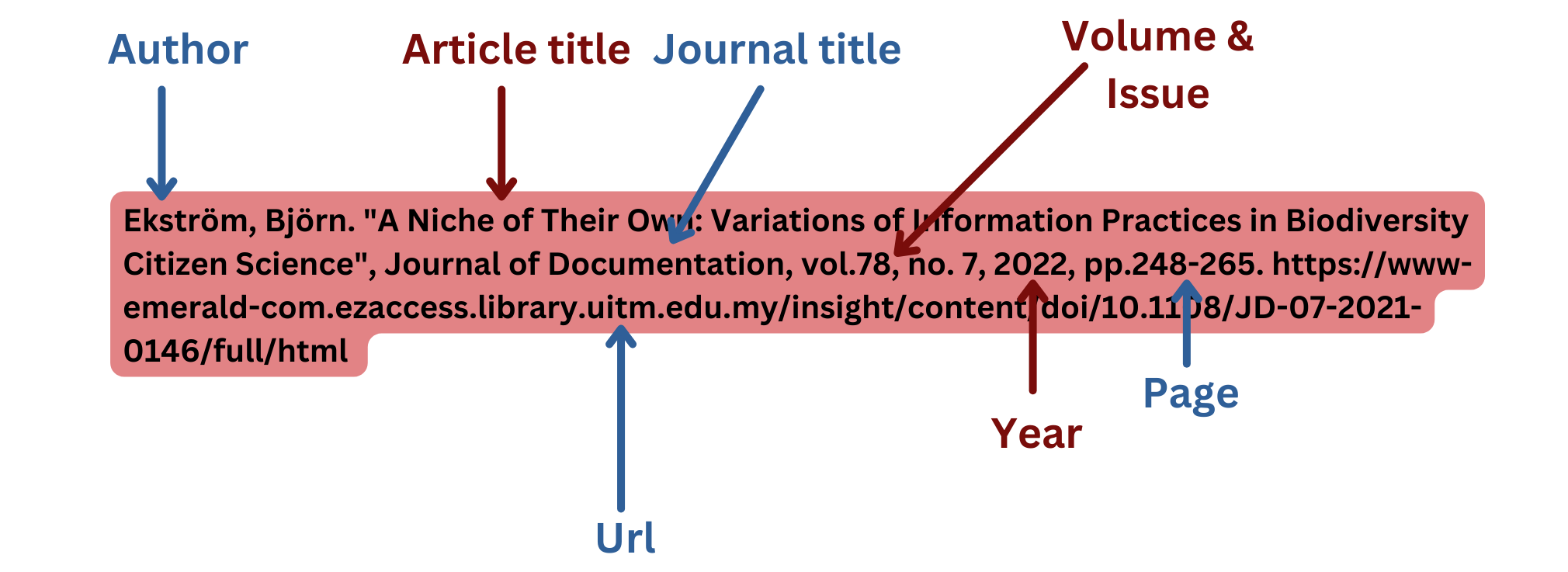
| In-text citation | Reference list |
| (Author Page) | Last Name, First Name. Title of Book. E-book, Publisher, Publication Date. |
| Examples | |
| (Harries 89) | Harries, Karsten. Art Matters: A Critical commentary on Heidegger’s “The Origin of the Work of Art”. E-book, Springer Dordrecht, 2009. |

Material on the Web often falls into one of the material types already covered in this guide. Information published on the Web is not necessarily a webpage. In such cases, follow the instructions for the material type in question (e.g. research report, e-book).
| In-text citation | Reference list |
| (Author/Owner) | Author/Owner of webpage."Title of Webpage" Name of Website, URL. Accessed date. |
| Example | |
| (Perpustakaan Tun Abdul Razak) | Perpustakaan Tun Abdul Razak."Predatory Journals" Perpustakaan Tun Abdul Razak, https://library.uitm.edu.my/en/research-ptar/predatory-journals-ptar. Accessed 13 March 2024. |
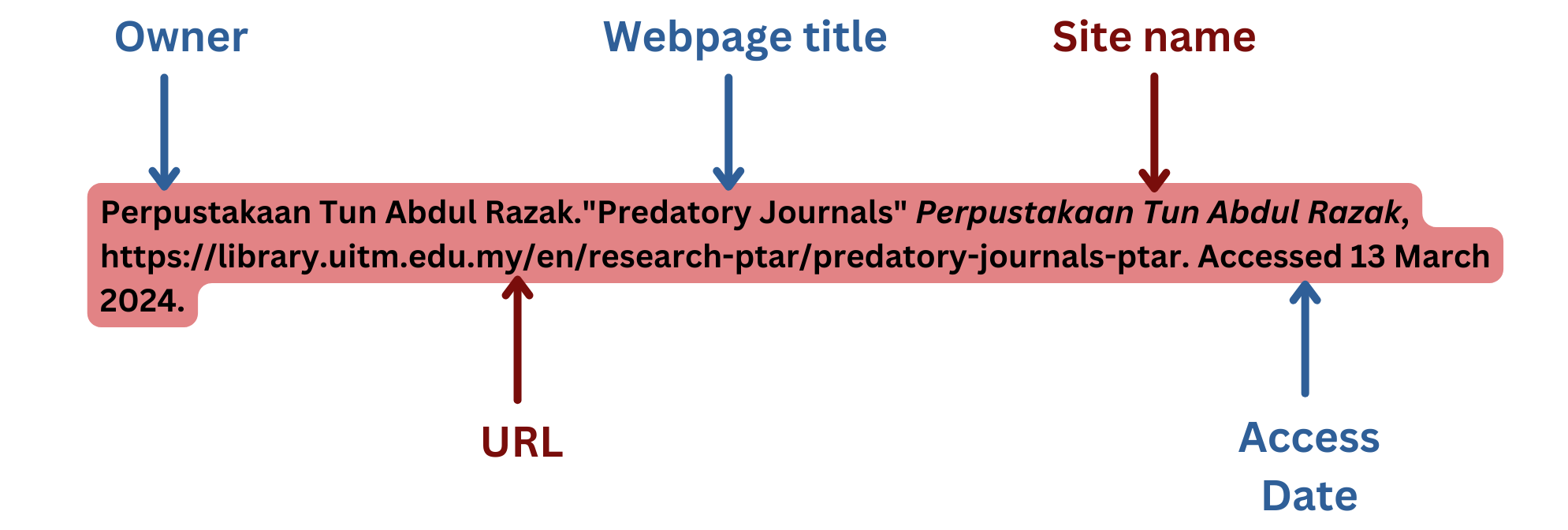
| In-text citation | Reference list |
| (Author(s) Year) | Author(s) surname(s), Initial(s). (Year of publication). Title of book: subtitle if any. Edition followed by ed. (if not the first edition) Place of publication: Publisher. |
| Examples | |
| (Bernstein 2021) | Bernstein, J. (2021). Google apps made easy: learn to work in the cloud. 7th ed. United States: CreateSpace. |
| (Giddens and Sutton 2021) |
Giddens, A. and Sutton, P.W. (2021). Sociology. 9th ed. Cambridge: Polity Press. |
| (Shortle et al. 2018) |
Shortle, J.F., Thompson, J.M., Gross D. and Harris, C.M. (2018). Fundamentals of queueing theory. 5th ed. New Jersey: Wiley. |
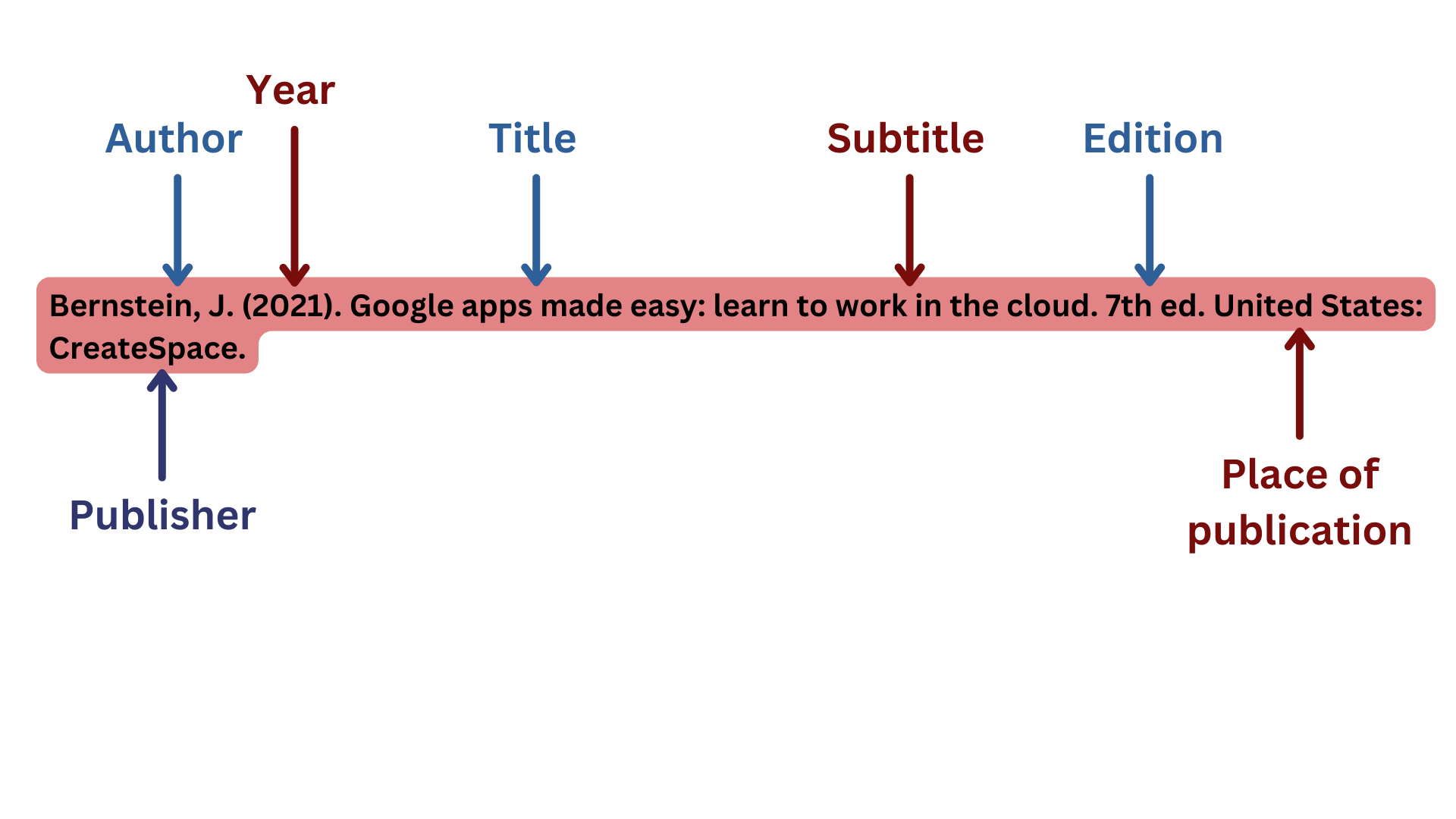
Use when referring to a single chapter in an edited book.
| In-text citation | Reference list |
| (Chapter author’s surname Year) | Chapter author(s) surname(s), Initial(s). (Year of publication). Title of chapter. In: Book editor(s) surname(s), Initial(s)., followed by ed. or eds. Title of book: subtitle if any. Edition followed by ed. (if not the first edition) Place of publication: Publisher, page number(s) of chapter. |
| Example | |
| (Rodgers et al. 2023) |
Rodgers, A.S., Agg, C., Gironacci E., Collingwood J.F. and Popham T.J. (2023). An innovative framework for the design of higher education STEM induction programmes. In: Willison, D. and Henderson, E., eds. Perspectives on enhancing student transition into higher education and beyond. United States: IGI Global, pp.69-94. |
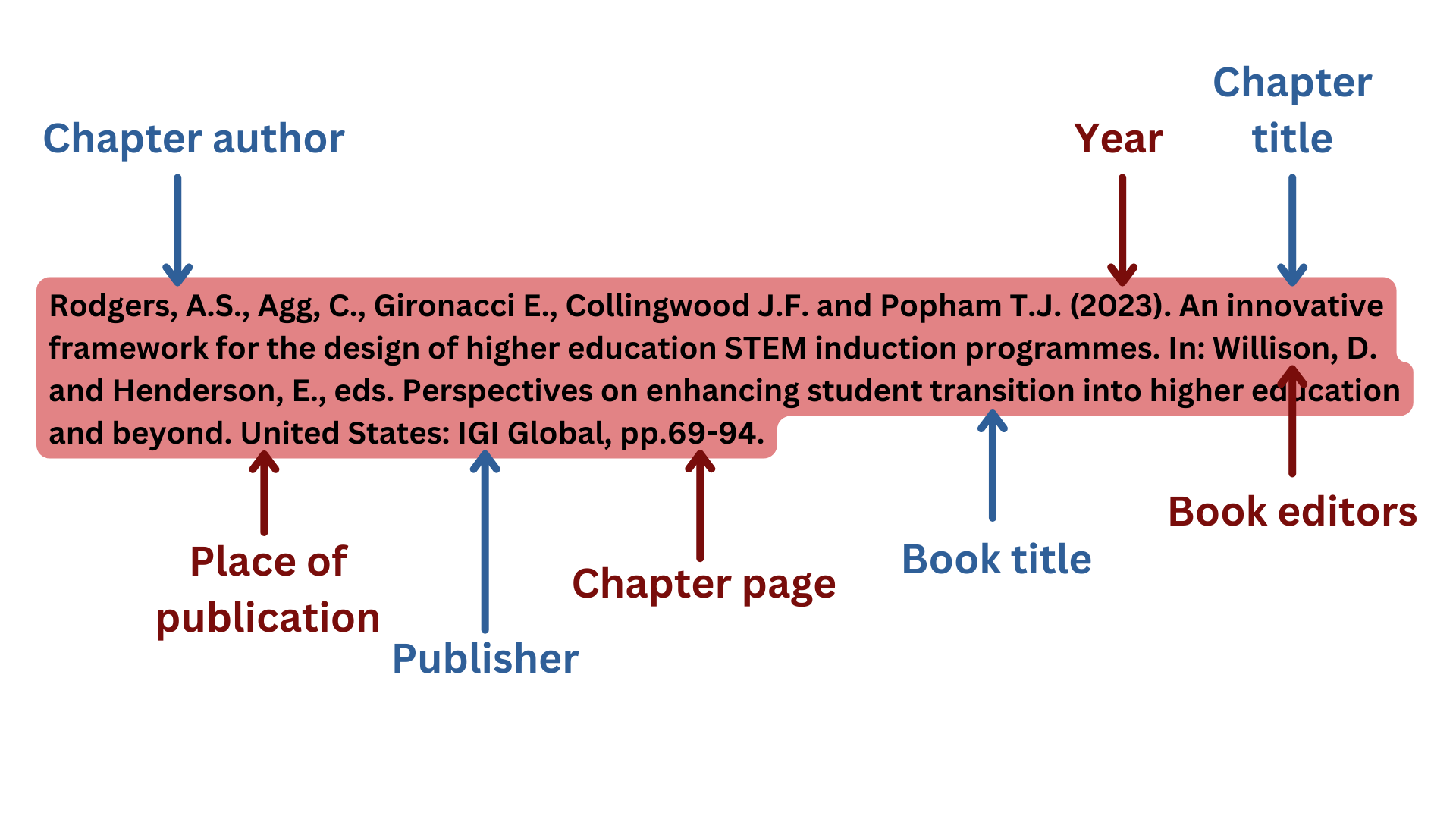
Use when referring to the entire book
| In-text citation | Reference list |
| (Editor Year) | Editor(s) surname(s), Initial(s)., followed by ed. or eds. (Year of publication). Title of book: subtitle if any. Edition followed by ed. (if not the first edition) Place of publication: Publisher. |
| Example | |
| (Willison and Henderson 2023) |
Willison, D. and Henderson, E., eds. (2023). Perspectives on enhancing student transition into higher education and beyond. United States: IGI Global. |
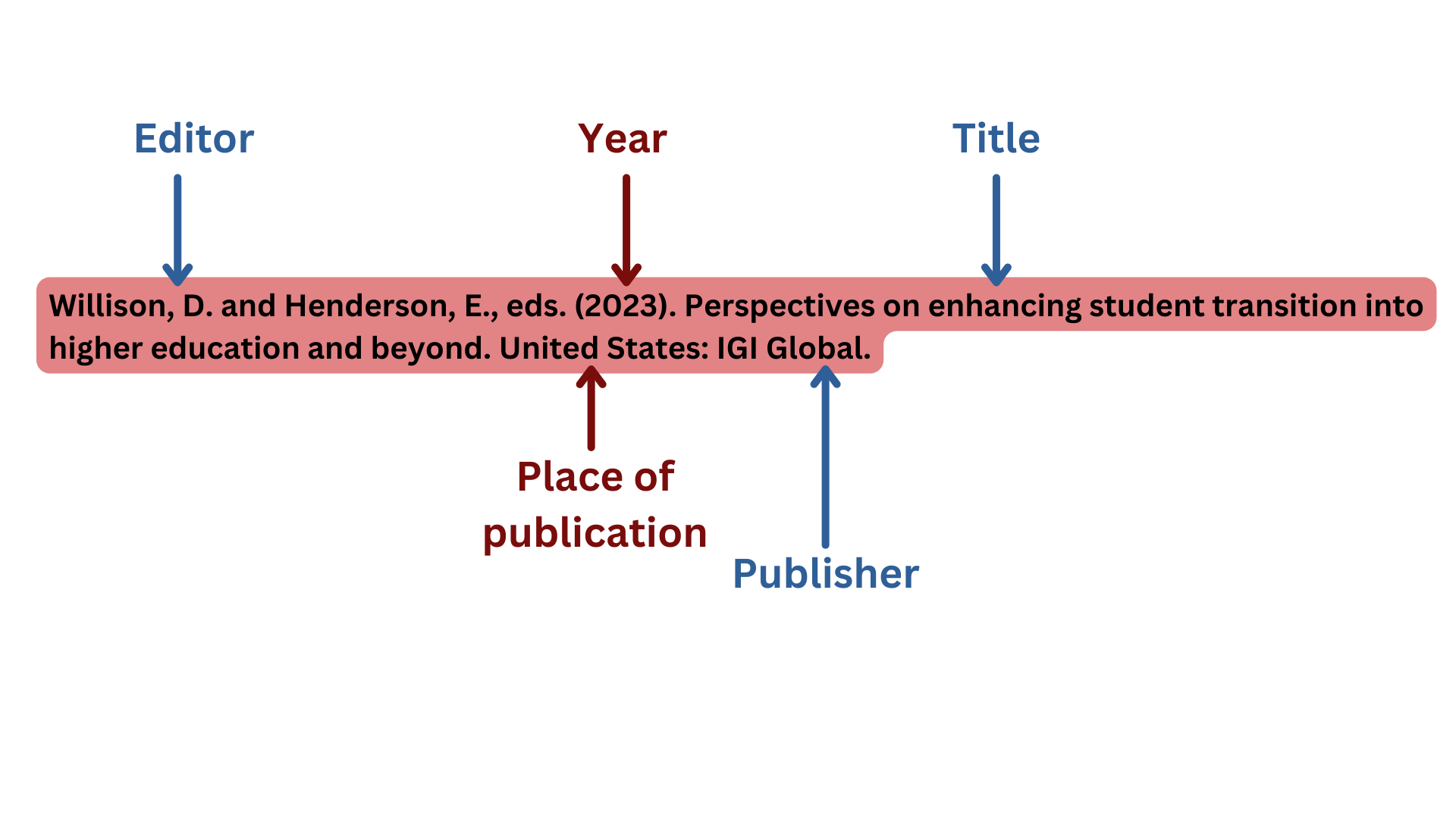
| In-text citation | Reference list |
| (Author Year) | Author(s) surname(s), Initial(s). (Year of publication). Title of article. Title of journal [online], volume number(issue/number, or date/month of publication if volume and issue are absent), page numbers or Article eLocator number (if any). Available from: library database name, or URL or DOI if accessed online from somewhere other than a library database [accessed date]. |
| Examples | |
|
(Ekström 2022) |
Ekström, B. (2022). A niche of their own: variations of information practices in biodiversity citizen science. Journal of Documentation [online], 78(7), Article e0274960. Available from: https://doi-org.ezaccess.library.uitm.edu.my/10.1108/JD-07-2021-0146 [accessed 30 August 2023]. |
| (Ekström 2022) | Ekström, B. (2022). A niche of their own: variations of information practices in biodiversity citizen science. Journal of Documentation [online], 78(7), pp.248-265. Available from: Emerald Insight [accessed 30 August 2023]. |
| (Ekström 2022) | Ekström, B. (2022). A niche of their own: variations of information practices in biodiversity citizen science. Journal of Documentation [online], 78(7), pp. 248-265. Available from: https://www-emerald-com.ezaccess.library.uitm.edu.my/insight/content/doi/10.1108/JD-07-2021-0146/full/html [accessed 30 August 2023]. |
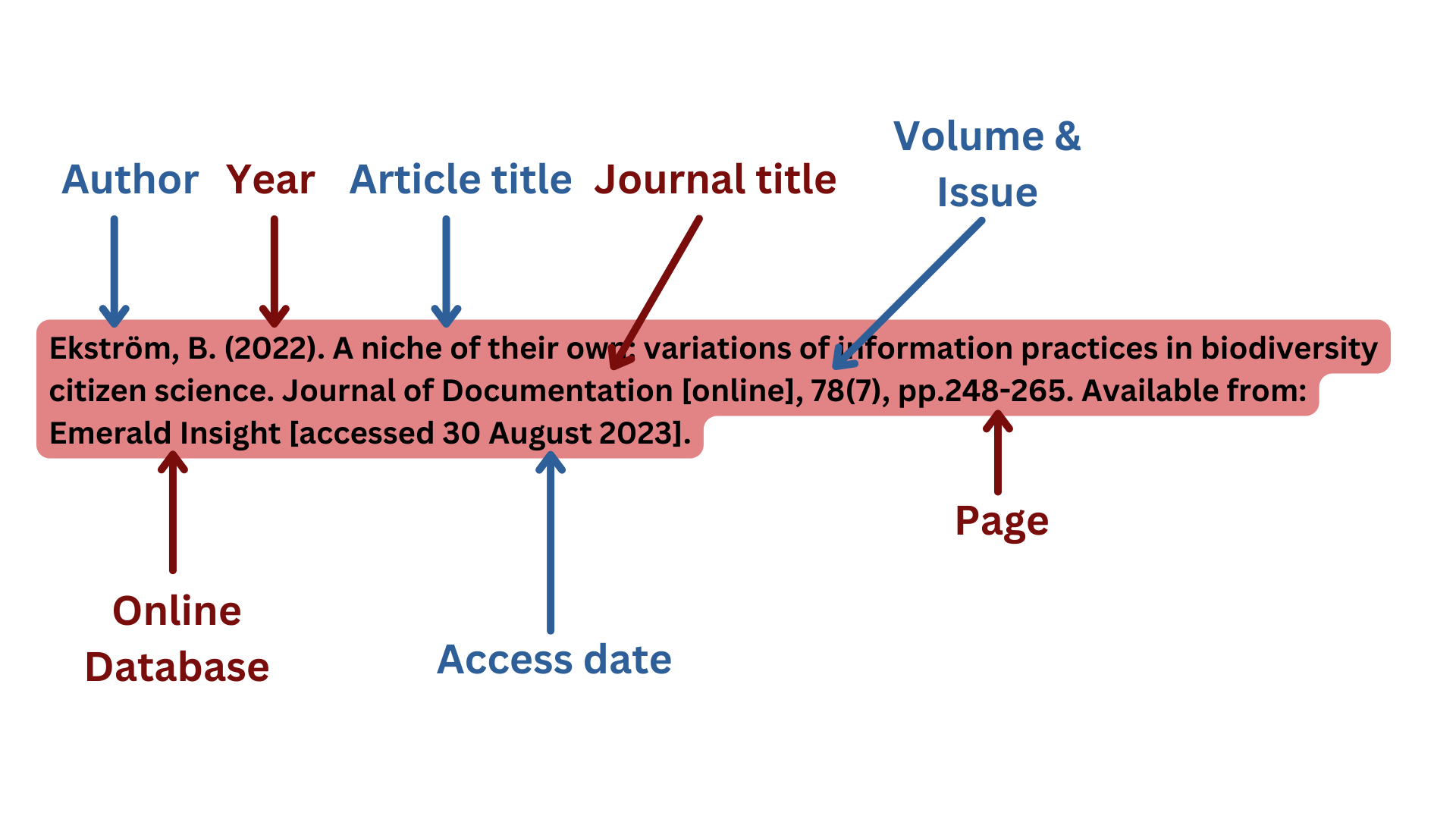
| In-text citation | Reference list | |
| (Author Year) | Author(s) surname(s), Initial(s). (Year of publication). Title of e-book: subtitle if any [online]. Edition followed by ed. (if not the first edition) Place of publication (if any): Publisher. Available from: library database name, or URL if accessed online from somewhere other than a library database [accessed date]. | |
| Examples | ||
| (Harries 2009) | Harries, K. (2009). Art matters: a critical commentary on Heidegger’s “The Origin of the Work of Art”. Netherlands: Springer Dordrecht. Available from: https://link-springer-com.uitm.idm.oclc.org/book/10.1007/978-1-4020-9989-2 [accessed 13 March 2024]. | |
| (Harries 2009) |
|
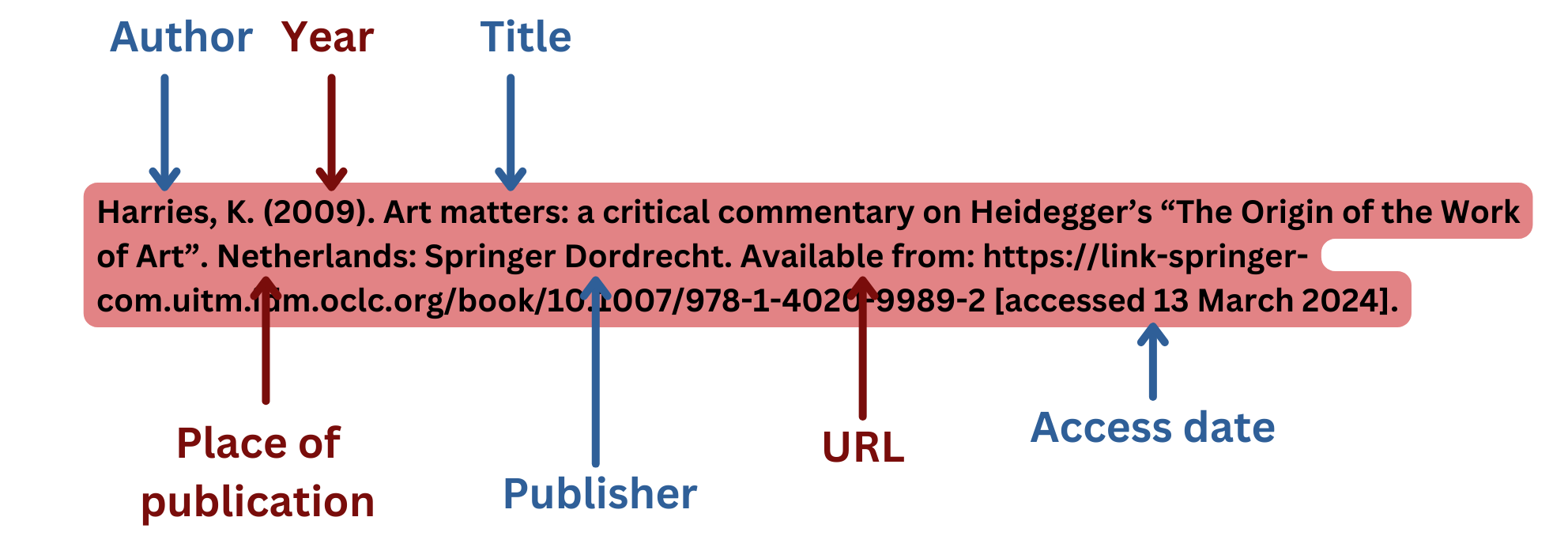
Material on the Web often falls into one of the material types already covered in this guide. Information published on the Web is not necessarily a webpage. In such cases, follow the instructions for the material type in question (e.g. research report, e-book).
| In-text citation | Reference list |
| (Author/Owner Year) | Author/Owner of webpage. (Year created or last updated). Title of webpage [online]. Available from: URL [accessed date]. |
| Example | |
| (Perpustakaan Tun Abdul Razak 2022) | Perpustakaan Tun Abdul Razak. (2022). Predatory journals [online]. Available from: https://library.uitm.edu.my/en/research-ptar/predatory-journals-ptar [accessed 13 March 2024]. |
